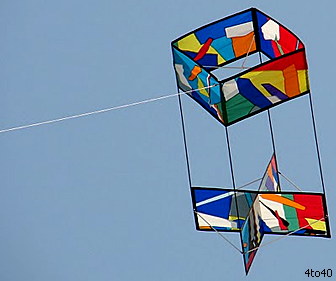 Box Kite Construction – First seen in the sky above Sydney, Australia in 1893, box kites have flown a long way since then. In kite history they say, even the Wright brothers flew kites to learn the principles of aerodynamics before their maiden mechanical flight. The best way to learn about aerodynamics is to fly kites and if done safely it is one of the most thrilling experiences. Kite making is a fairly easy exercise, and contrary to popular belief, box kite construction is also a simple task. Box kites are generally made with paper or plastic attached to a light but, strong wooden skeletal structure in the shape of a box. You do not need any special techniques or apparatus to fly a box kite, all you need is an open space and moderate wind.
Box Kite Construction – First seen in the sky above Sydney, Australia in 1893, box kites have flown a long way since then. In kite history they say, even the Wright brothers flew kites to learn the principles of aerodynamics before their maiden mechanical flight. The best way to learn about aerodynamics is to fly kites and if done safely it is one of the most thrilling experiences. Kite making is a fairly easy exercise, and contrary to popular belief, box kite construction is also a simple task. Box kites are generally made with paper or plastic attached to a light but, strong wooden skeletal structure in the shape of a box. You do not need any special techniques or apparatus to fly a box kite, all you need is an open space and moderate wind.
How to Build a Box Kite
The design of a kite should adhere to the principals of aerodynamics and the parts should be able to withstand and distribute these forces. The movement of the kite is manipulated with a control line and the flyer needs to interpret the tension felt on the line to make adjustments. Building any kite requires patience and precision, and box kite construction is no different. Let us take a look at what goes into box kite construction in brief.
- Material required: 4 wood sticks 12-16 inches, these can be either bamboo or balsa sticks. 4 same length cross pieces of wood, strings, pieces of paper or plastic and some glue.
- Cut four leg pieces of same length, about 12-16 inches. The thickness of these legs should be between 1/8 to 3/8 inches.
- Attach these leg pieces in a box like structure with the help of the cross pieces and string.
- If you have chosen a 12 inch leg, attach the cross pieces at both the ends, one four inches from the top and one four inches from the bottom.
- Fasten all the joints together with the help of a string and make sure the knots are not loose.
- Cover the top and the bottom half of the box with paper or thin plastic. You can cut 4 different pieces and glue them together covering the skeletal structure up to the cross pieces at the top and bottom.
- Once the structure is ready attach a bridle string to the top and bottom end of the kite. Use a strong bridle string that will withstand the pressure of the wind and the kite.
- Last, but not the least, connect the bridle string to the lift line, you can attach the lift line in the middle or change the position to alter the characteristic of the kite.
You can use a combination of materials and make changes to the design to make it interesting. The use of fiber glass rods instead of wood is quite popular while some professional kite makers also use graphite rods. In an effort to make the kite lightweight some people use only two cross pieces instead of four. Wood doweling is also used instead of the traditional string and some times clips are used to fasten the structure in place.
Box kite construction is a very fulfilling task, and the pleasure you get after your kite catches the wind and flies into the clouds is immense. Some have even gone as far as calling building kites a therapeutic experience. Whatever the reason behind kite flying, there is no doubt that, it is a very pleasurable activity enjoyed by young and old alike.
 Kids Portal For Parents India Kids Network
Kids Portal For Parents India Kids Network






